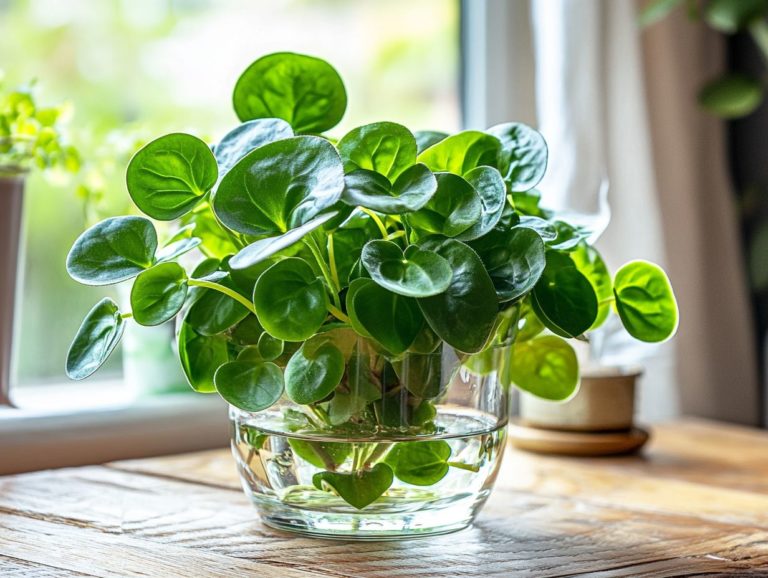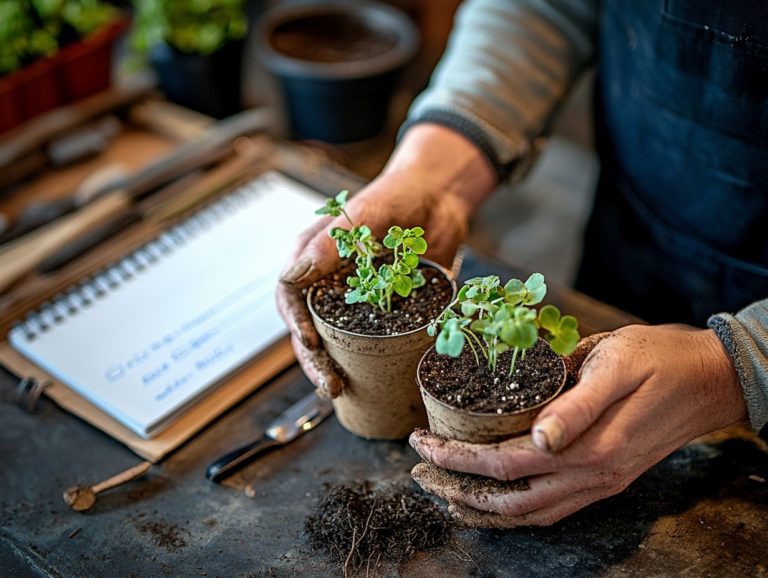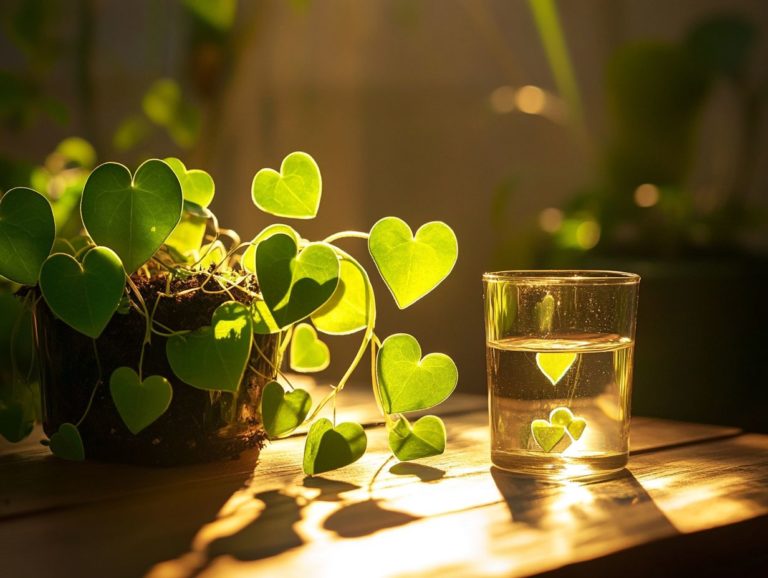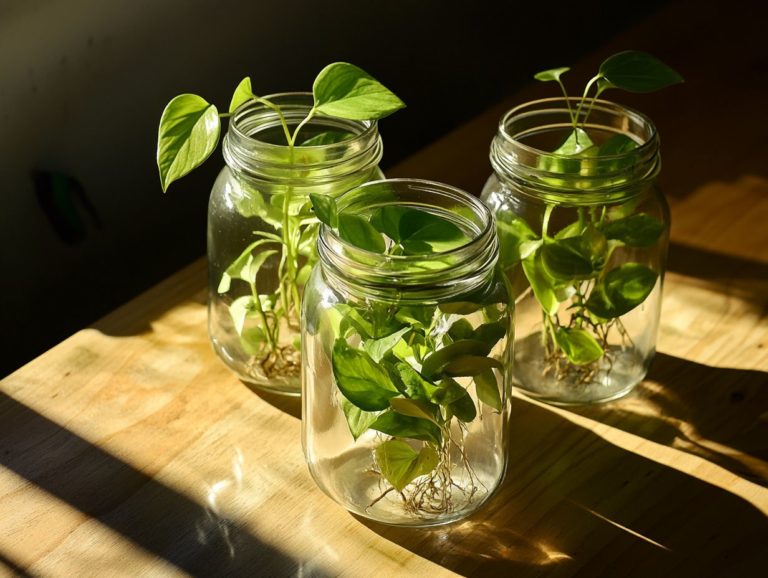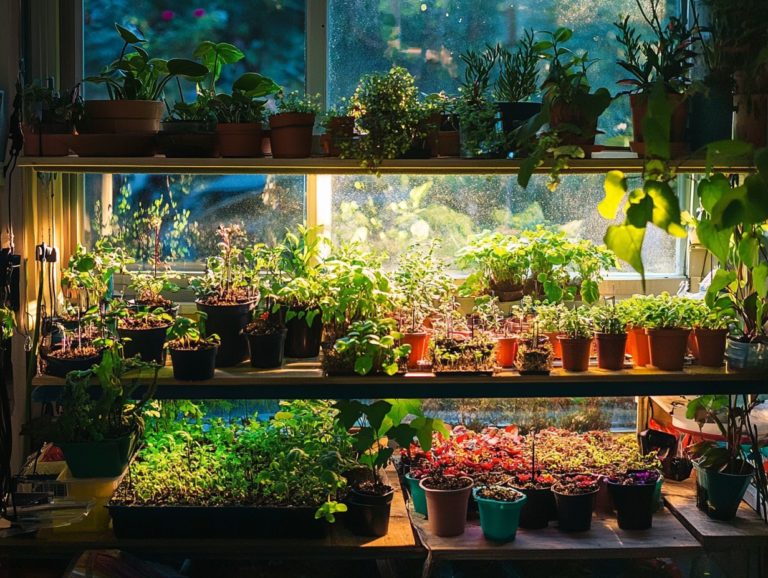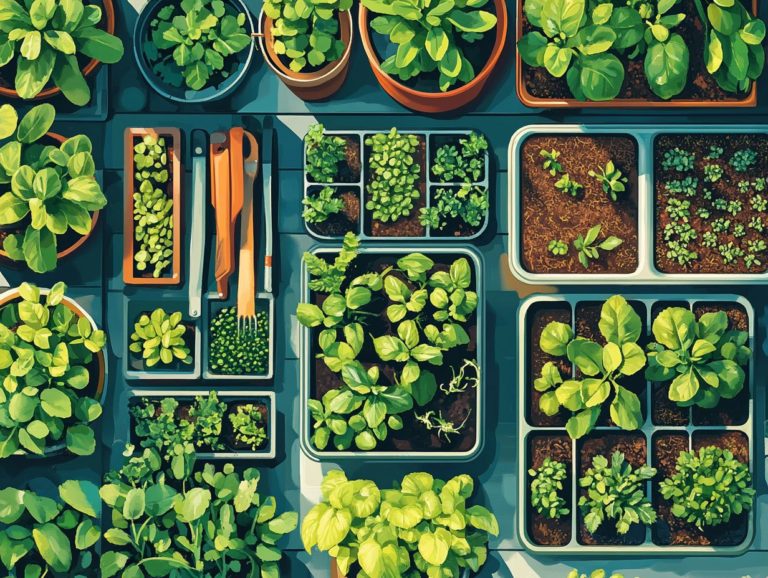Quick Guide to Propagating Philodendrons
If you’re eager to enhance your indoor jungle, try propagating philodendrons. This guide will walk you through various methods, covering both water and soil techniques.
You’ll get practical advice on gathering the right materials. A clear, step-by-step process for each method is included.
Prepare to unleash your green thumb and see your indoor garden come to life!
Contents
- Key Takeaways:
- What is Plant Propagation?
- Methods of Propagating Philodendrons
- Choosing the Right Plant for Propagation
- Preparing for Propagation
- Step-by-Step Guide to Propagating Philodendrons
- Caring for Newly Propagated Philodendrons
- Frequently Asked Questions
- What is the best method for propagating philodendrons?
- When is the best time to propagate philodendrons?
- How do I prepare a philodendron cutting for propagation?
- Do I need to use rooting hormone when propagating philodendrons?
- What type of soil should I use for propagating philodendrons?
- How long does it take for a philodendron cutting to root?
Key Takeaways:

- Plant propagation creates new plants from existing ones.
- Use water or soil for propagating philodendrons.
- Choose a healthy plant and gather your materials first.
- Healthy plants thrive!
What is Plant Propagation?
Plant propagation is your gateway to creating new plants from existing ones. You can achieve this through methods such as cuttings, seeds, and division.
This practice is favored by gardeners eager to expand their houseplant collection, like the beloved philodendron, or to share their green treasures with friends and family.
By grasping the fundamentals of propagation, you ll be well-equipped to cultivate healthy plants that thrive indoors and outdoors.
The importance of plant propagation goes beyond aesthetics; it enhances the variety of plants and ensures the longevity of different species.
Different methods cater to different plants. For instance, cuttings are ideal for low-maintenance plants like philodendrons, which can easily root in water or soil. In contrast, seeds provide a broader genetic variety for the adventurous gardener.
Division is perfect for perennial plants, allowing you to rejuvenate older specimens. Engaging in these methods not only improves plant health but also creates a rewarding gardening experience.
This makes it easier for you to connect with nature and share the joys of green living with others, including tips for fertilizer use.
Methods of Propagating Philodendrons
You ll find an array of effective methods for propagating philodendrons, each tailored to your unique preferences and gardening style.
Whether you choose water propagation or soil propagation, these techniques empower you to create new plants from cuttings.
This way, you can fully embrace the beauty and benefits of various philodendron varieties in your home.
Water Propagation
Water propagation offers a delightful and straightforward approach to grow new philodendron plants from stem cuttings. You can witness the enchanting rooting process firsthand.
To embark on this journey, place your cuttings in a container filled with clean water, ensuring that the nodes small bumps on the stem that grow roots are submerged while keeping the leaves above the waterline.
Your cuttings should ideally be between 4 to 6 inches long, with at least one node included to ensure successful rooting. Changing the water weekly is crucial; it keeps things fresh and helps prevent any pesky algae from developing.
Since philodendrons thrive in indirect sunlight, position your container in a bright spot that avoids direct rays. This significantly boosts root development.
A warm environment will also work wonders, helping to accelerate the rooting process and ultimately leading to a vibrant new plant.
Soil Propagation
Soil propagation lets your cuttings thrive right in the soil! This excellent method for propagating philodendrons allows your cuttings to establish roots directly in a well-suited growing medium. You must carefully select potting soil that drains well while maintaining optimal temperature and humidity levels to encourage vigorous root growth.
When choosing the right potting soil, prioritize a mix specifically formulated for aroids (plants from the family Araceae, including many popular houseplants) or tropical plants. These blends retain some moisture while allowing excess water to escape easily, striking the perfect balance.
Proper drainage is paramount. Using containers with drainage holes significantly minimizes the risk of root rot.
To create an ideal environment for growth, maintain a warm temperature between 70-80 F and aim for humidity levels around 60-80%, especially for tropical plants. This combination fosters a conducive atmosphere that promotes healthy development.
Regularly misting your cuttings or using a humidity dome will provide that extra moisture, ensuring your philodendrons thrive during their early stages.
Choosing the Right Plant for Propagation
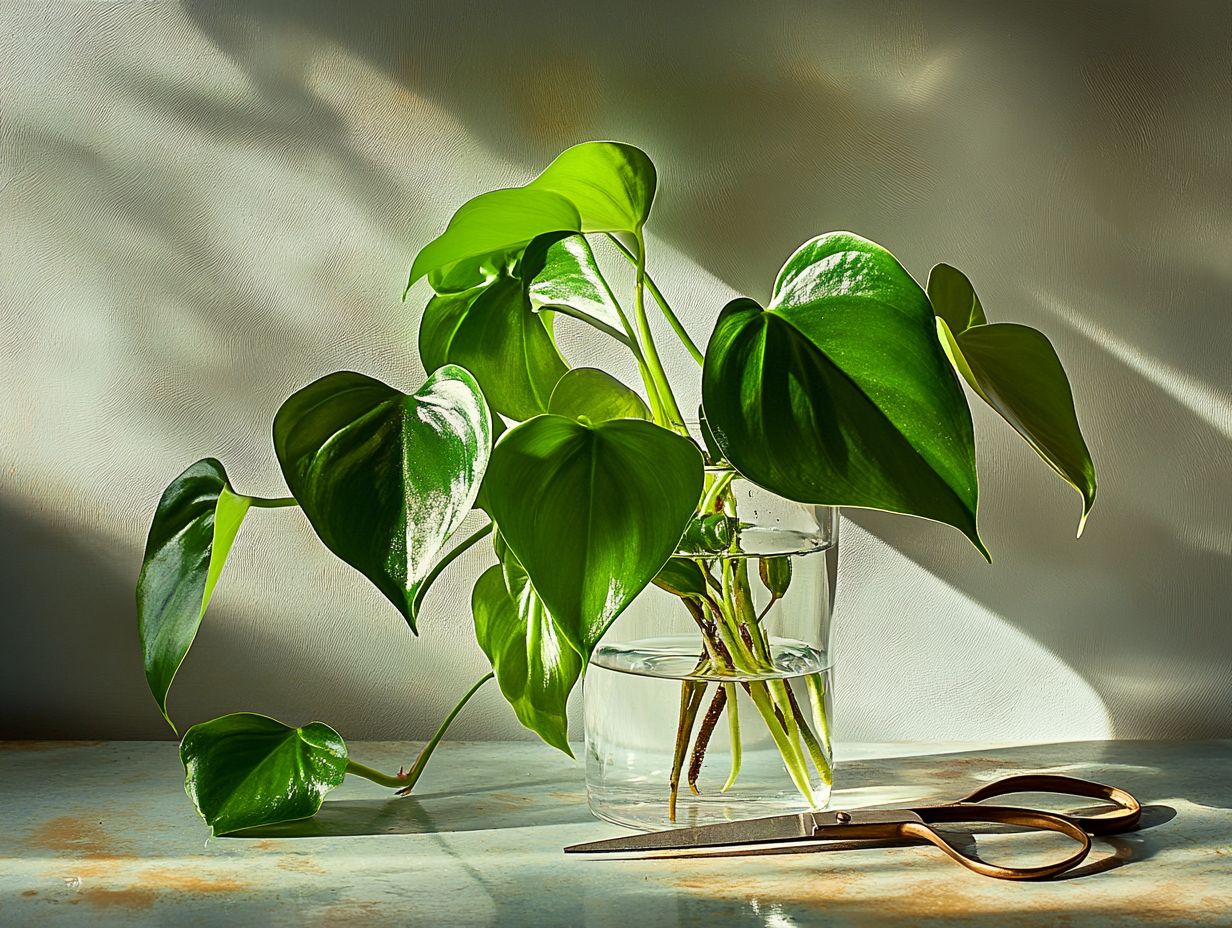
Choosing the ideal Philodendron for propagation is essential for achieving robust new growth and fostering a healthy plant. Seek out specimens with strong stems and vibrant leaves, free from any signs of disease or pests. This practice is crucial for anyone interested in indoor gardening.
These characteristics greatly enhance your chances of successful propagation and ultimately lead to flourishing plants in your care.
Identifying Healthy Philodendrons
Identifying healthy philodendrons is key to successful propagation. It requires a keen eye for various aspects of the plant, including its leaves, stems, and overall growth pattern. When evaluating your philodendrons, look for vibrant, green leaves that show no signs of yellowing or damage. These indicators suggest robust health and readiness for propagation.
Pay attention to the texture of the leaves; they should feel firm and glossy, not dull or brittle. This glossy finish means your plant is well-hydrated and thriving. Next, assess the stems they should feel sturdy and strong, devoid of any soft spots or lesions that hint at underlying health issues.
Regular pruning encourages bushy growth and helps eliminate any dead or unhealthy foliage, creating a nurturing environment for your plants. Proactive pest control measures are essential. Infestations can quickly undermine your plant s vitality, highlighting the importance of attentive care in nurturing your philodendrons.
Preparing for Propagation
Preparing for propagation means gathering the finest materials and tools to ensure a seamless and successful process. This maximizes your chances of nurturing stunning new philodendron plants.
Grab your sharp scissors now! Precise cuts are key to healthy growth. Have suitable containers for water propagation and high-quality potting soil for soil propagation ready. Each item plays a crucial role in setting the stage for your plants to thrive.
Gathering Materials and Tools
Gathering the right materials and tools is essential for successfully propagating philodendrons. This lays a strong foundation for robust plant growth. You ll want sterilized scissors for precise cuts, along with healthy cuttings, well-draining potting soil, and suitable containers for water propagation. Incorporating a rooting hormone can also enhance your success.
Opt for clear glass containers to easily monitor root development during water propagation. For soil methods, plastic or clay pots with drainage holes are ideal. Ensure all your tools and materials are clean and sterilized to minimize the risk of harmful pathogens that could jeopardize your plants health.
Consider using a humidity dome to enhance moisture retention for soil propagation. This creates a thriving environment for root establishment. By carefully selecting these items, you can cultivate the perfect setting for your philodendrons to flourish!
Now that you’re prepared, it s time to start propagating your philodendrons! Dive in and watch your garden thrive!
Step-by-Step Guide to Propagating Philodendrons
This step-by-step guide to propagating philodendrons offers you clear and concise instructions for both water and soil propagation methods, giving you the power to grow new plants with confidence and enjoy the indoor gardening experience.
By following these detailed steps, you’ll gain the gardening know-how necessary to encourage new growth and nurture healthy philodendrons for your home or garden.
Water Propagation Method
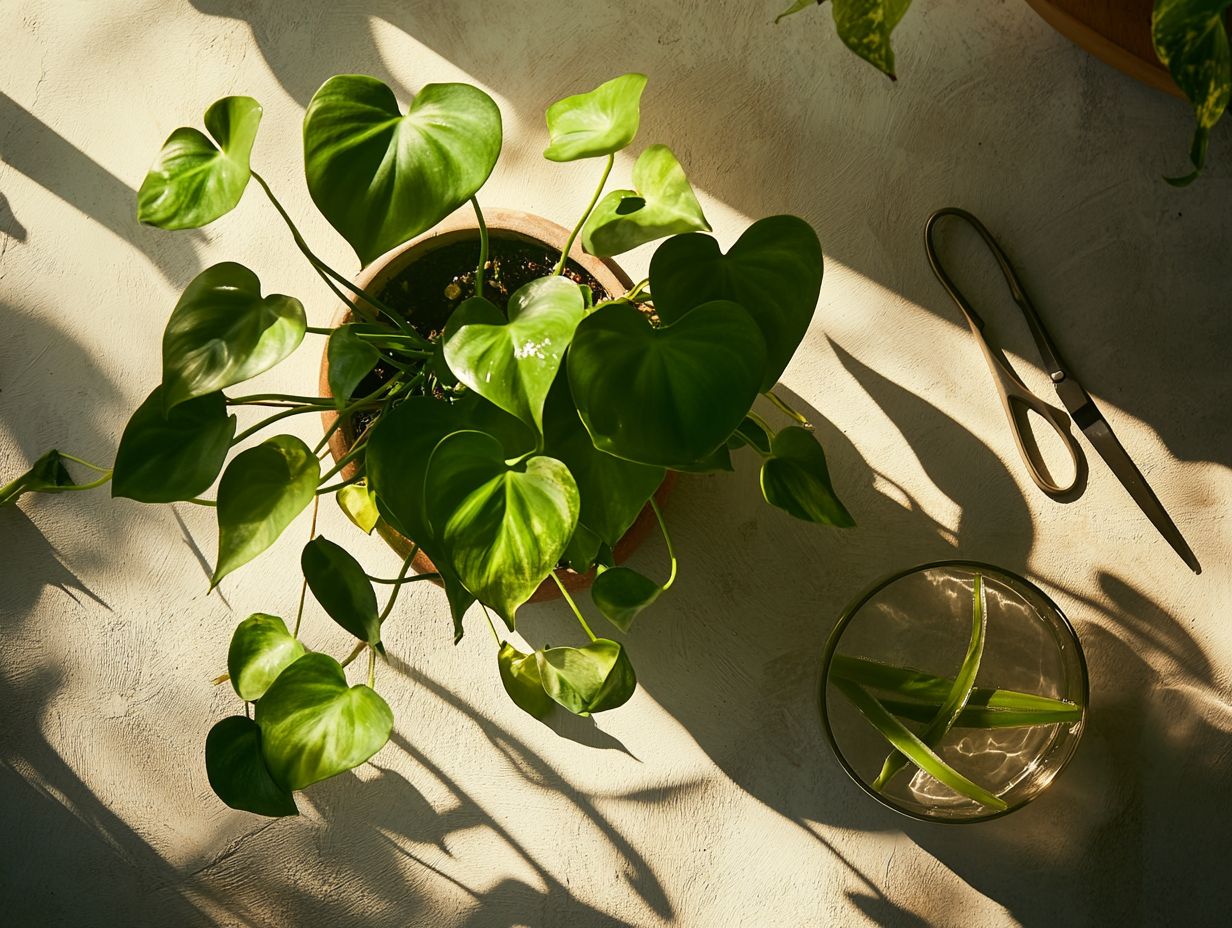
Watch as your cutting flourishes in water it’s a fascinating journey! The water propagation method for philodendrons offers an engaging experience. You can witness the roots develop as your cutting thrives in a container of water. To start, select a healthy cutting about 4-6 inches long, making sure it includes a node, and place it in a clear container filled with water.
This transparency enables you to monitor the root development and the overall health of your cutting. Choosing the right container is essential. Glass jars or vases provide stability and showcase the roots as they flourish. Avoid materials that could leach toxins into the water.
Make sure your plant gets bright, indirect light, as this promotes healthy growth without the risk of leaf burn risk. Changing the water regularly ideally once a week helps prevent stagnation and algae buildup, both crucial for maintaining the plant’s vitality.
With time, those roots will grow long and robust, preparing your cutting for a successful transition into soil.
Soil Propagation Method
The soil propagation method for philodendrons is a remarkably simple approach that allows your cuttings to develop roots directly in potting soil, which helps develop a strong root system. To propagate in soil, prepare a pot filled with well-draining potting soil and create a small hole for the cutting, ensuring that at least one node is buried to promote successful rooting.
Choosing the right potting soil is essential. A mix with perlite or vermiculite enhances drainage, which is vital for preventing root rot. It s also important to ensure your pot has adequate drainage holes to allow excess water to escape, helping roots grow well.
Once you ve positioned the cutting, maintaining appropriate moisture levels is crucial keep the soil damp but not soggy. Regularly check the moisture by feeling the soil with your fingers; if it s dry a couple of inches down, it s time to give it a drink. This meticulous balance not only aids in optimal root development but also sets your plant up for a flourishing future. Proper watering techniques are key to successful plant care.
Caring for Newly Propagated Philodendrons
Caring for your newly propagated philodendrons is essential for ensuring their successful growth and development after rooting, regardless of whether you’ve used water or soil methods. Key factors in their care include providing the right light exposure, maintaining optimal humidity levels, and closely monitoring their health to avert any potential disease or pest problems.
Regular pruning and checking for leaf yellowing can also contribute to healthy growth. By focusing on these elements, you’ll help your philodendrons thrive and flourish in your home!
Transplanting and Maintenance Tips
Transplanting your new philodendrons is a crucial moment in their journey to becoming vibrant, thriving plants. This step helps them adjust to their new surroundings and build strong roots.
Select a pot that s slightly larger than the current one. Ensure it has excellent drainage for healthy growth.
Transplant during spring or early summer when your plant is actively growing. Use a well-draining potting mix that retains moisture without becoming waterlogged.
After transplanting, place your plant in bright, indirect light and keep the soil moist. Allow the top inch of soil to dry out between waterings.
Keep humidity levels high, as philodendrons thrive in humid conditions. Regularly check for pests and use suitable fertilizers every few months to encourage vigorous growth.
Frequently Asked Questions
What is the best method for propagating philodendrons?
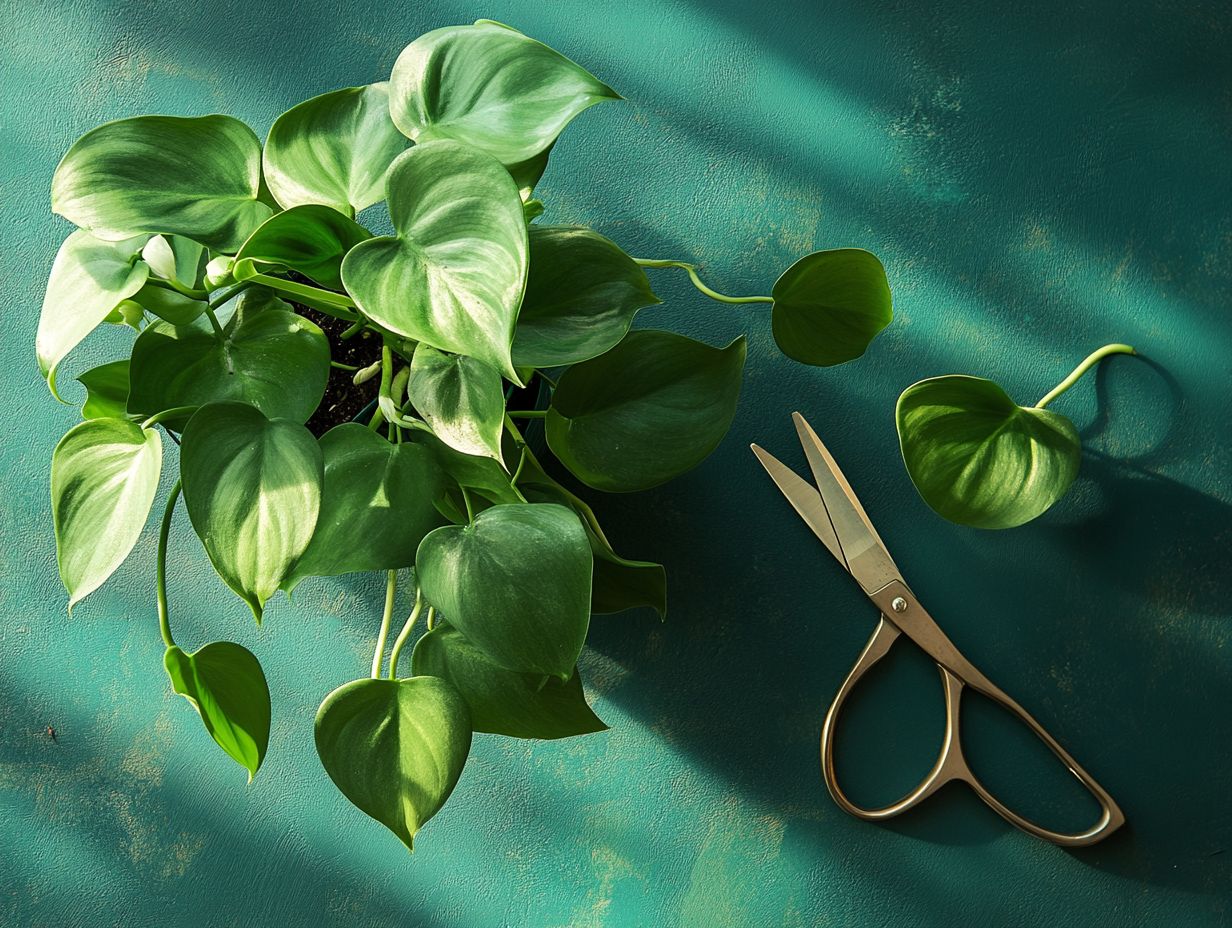
The most common and effective method for propagating philodendrons is through stem cuttings. Ensuring the cutting length is appropriate can also enhance rooting success.
When is the best time to propagate philodendrons?
The best time to propagate philodendrons is during the spring and summer months when the plant is actively growing and has more energy to produce new roots. This period is ideal for all propagation methods.
How do I prepare a philodendron cutting for propagation?
To prepare a philodendron cutting, use a sharp, clean knife or shears to cut a healthy stem just below a node, which is where the leaf or aerial root attaches to the stem. Make sure the cutting is at least 4-6 inches in length.
Do I need to use rooting hormone when propagating philodendrons?
While it is not necessary, using rooting hormone can increase the chances of success when propagating philodendrons. This hormone helps stimulate root growth in the cutting.
What type of soil should I use for propagating philodendrons?
For best results, use a well-draining potting mix that is specifically designed for houseplants. You can also mix equal parts peat moss and perlite for a DIY potting mix.
How long does it take for a philodendron cutting to root?
It can take anywhere from 2-6 weeks for a philodendron cutting to develop roots. Patience is key, and it is important to keep the cutting in a warm and humid environment to promote root growth.

